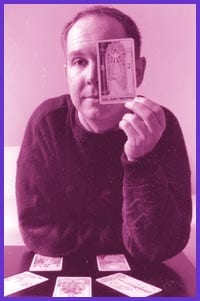The queens, the Empress, the lovers – if you aren’t familiar with the cards of Tarot, this might sound like a gala drag show.
And it could be, if your cards are being read by queer Tarot card consultant James Wells. He is able to find something for everyone in the cards. There’s the theatrical, confident world of the Queen Of Wands, and the manipulator and dominatrix, the Queen Of Swords. There’s love and hate, life and death, sadness and hope. Christ, the Pope, the Goddess and the devil all make their appearances.
“Like a dream, each card has so many levels and layers of meaning,” Wells says. “I lead people through a process of self-discovery. I stress that my work is not prediction-based. I believe that seeing things in a different way can change you. If you can change yourself, you can change your outcome. I am putting the power where it belongs – in your hands.”
The approach makes him an in-demand consultant – with nary a crystal ball in sight. In the pre-millennial sea of pre-packaged spirituality, queer Tarot consultant James Wells offers an unusual vision: his own.
“I was called to this, going way back. Even from the age of two I remember seeing lights and hearing voices,” says the 32-year-old. He’s a going concern, booked solid for guest appearances at symposiums and workshops, and always busy with consultation appointments.
Wells has been reading stories in the cards since he was 12. He was raised Protestant, but when he picked up his first deck, it felt right. Despite this attraction to an occult practice, Wells never saw the need to give up the Christian God; he never saw the two worlds as divided. The dominant philosophies that categorize and judge never spoke to him as loudly as the whispered secrets of the Tarot.
About 1,500 years after Christ, somewhere in Italy, this wicked pack of cards was born. Entrenched with Christian, mythological, and goddess symbolism, the Tarroci game was banned by the medieval church. It survived with popularity as its derivation, playing cards. In the parlours of heretics, its full language survived.
“The Tarot is a fluid tool and it is a tool that speaks in imagery. Images are the language of the soul,” Wells says.
Wells has somehow managed to bridge his spiritual worlds, and maintain his integrity as a gay man. He remains active in the Anglican church, playing the organ and designing alternative liturgies. His fellow parishioners have never accused him of any satanic plots to take over the world; Wells feels valued in the church for his individuality and perspective.
“I walk a Christian and an earth-centred path,” Wells says. “Christianity is not what the church has inherited – it’s the insecurities of [the apostle] Paul that are screwing up western society.”
Even as a Christian, the myth of the male divinity isn’t the only one for Wells. He has always been interested in the notion of feminine deities illustrated in the cards. And he figures it is in androgyny that homosexuals figure into the constellation.
“I don’t believe in a gender specific God,” he tells me, “but in the Oneness… and I feel that the gay and lesbian community has contributed a lot to the beauty of people’s spiritual lives. Some of the most beautiful artwork that graces cathedrals comes from that community, the music, even the clergy.
“In many traditions, gays have been seen as a blend of masculine and feminine, androgynous and ambiguous,” Wells says. This upsets some queers who are sick of expected polarities, but Wells sees this perception as a reflection of sacred mysteries, where divinity is expressed in a variety of gender roles.
“Gay men are stereotyped to seem like we are all tutu wearing fruit loops,” he laughs. “But I really believe that this embodiment of masculine and feminine qualities is something special we have found.”
Wells recognizes that the church and queer people have had a tormented relationship. Historically, the Christian church has been unfriendly toward homosexuality. At the same time, the call of God was a way for homosexuals to bow out of conventional marriages. Wells says he doesn’t feel gay men and women becoming priests and nuns were just hiding.
“I think the aesthetic and ritual appeal to gay and lesbian people. The incense, the chanting – good liturgy is good theatre. It’s about reenacting the myths.”

 Why you can trust Xtra
Why you can trust Xtra


